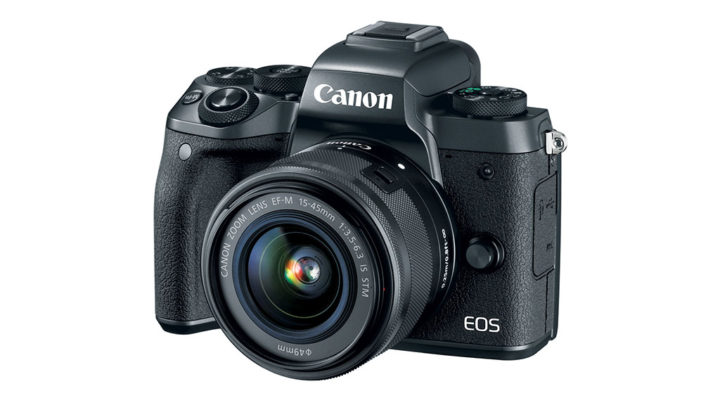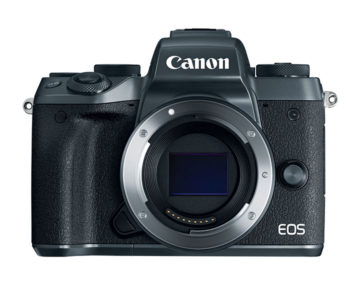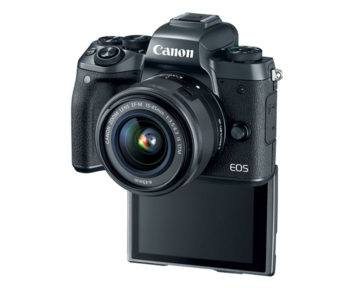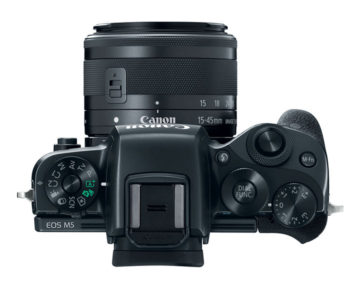
If the EOS M5 has been released two years ago, the same year that saw the arrival of products like the Sony a6000 or Fuji X-T1, I would be more excited. Today’s announcement tells me that Canon wants to play a little more seriously but in all honesty, the EOS M5 looks like yet another mirrorless camera with a viewfinder and a few interesting specifications. But let’s give it the benefit of the doubt before coming to any concrete conclusions …
The EOS M5 has a more user-friendly design in comparison to its predecessor. The more prominent grip, the SLR-esque design and the viewfinder make the camera more appealing to enthusiasts and advanced users. It weighs around 427g (body only) and naturally, it takes its place at the top of the EOS M pyramid.
The viewfinder is a 0.39-inch type with 2.36 million dots, a 120fps refresh rate and a 22mm eyepoint. Canon hasn’t revealed the magnification value nor the maximum refresh rate.
The LCD monitor is a little bit larger than usual (3.2″) with an excellent resolution of 1,620k dots. It has touch capabilities including the Touch and Drag AF fuction that allows you to change your focus point while composing with the EVF. The touch screen remains active during video recording so you can change the AF point. It can be tilted up 85° and down 180° for self portraits.
As for the ease of use, the EOS M5 offers more manual controls and 4 customizable buttons. We can appreciate the exposure compensation dial in addition to the two main exposures dials and the Custom modes on the main shooting mode dial.
Inside we find the same chip of the Canon 80D: a 24.2 MP APS-C CMOS sensor with a low-pass filter. The camera uses the DIGIC 7 image processor and has a sensitivity range of 100 to 25600 ISO. It shoot 14 bit RAW files.
One of the most exciting specifications of the EOS M5 is without a doubt the Dual Pixel CMOS AF.
Canon’s advanced phase detection system has been referred to as one of, if not the best AF system of its kind and is effective not only for stills but also for video. (Canon employs it in its Cinema series of camcorders as well as some DSLRs including the 80D and the recent 5D mark IV.) The camera uses the 24 million phase-difference sensors (present on over 80% of the entire sensor surface) to quickly and smoothly lock onto the subject. The AF area includes 49 points and there is also an AF Zone with 9 points available. You also get Face detection + Tracking using the touch screen. For manual focus, you get peaking and magnification assists.
The EOS M5 can shoot up to 7fps with continuous AF and 9fps with the AF locked on the first frame. The shutter mechanism has a fastest maximum speed of 1/4000s. There is no mention of an electronic shutter which means no silent mode or extended shutter speeds. The camera has an Easy Panning mode where it automatically selects the optimal shutter speed by analyzing the camera’s panning speed and how fast the subject is.
Concerning video, the camera can shoot in Full HD up to 60fps in MP4 format with a max. sensitivity of ISO 6400. Canon talks about a 5-axis stabilization system for video but the name is a little misleading: basically the camera combines software stabilization and the optical stabilization of select lenses (the EF-M 18–150mm f/3.5–6.3 IS STM and the EF-M 15–45mm f/3.5–6.3 IS STM, a lens firmware update will be required). With a non-compatible lens, digital stabilisation is still available.
Finally, the EOS M5 is packed with wireless options: you can use WiFi, NFC and Bluetooth. The last option is the most interesting because of the low-energy Bluetooth® Smart feature that allows you to maintain a constant connection between the camera and mobile device for remote control purposes (similar to what you could do with some Samsung cameras) without sacrifying the operability of the camera itself.

The battery life is good for 295 shots and 420 shots with the ECO Mode enabled.
Along with the camera, Canon also introduced the EF-M 18-150mm f/3.5-6.3 IS STM all-purpose zoom lens (29–240mm equivalent). It has a compact and lightweight design and optical stabilisation with up to 4 stops of compensation. There are now 7 lenses with the native EF-M mount.

The EOS M5 has some interesting specifications. The Dual Pixel CMOS AF system should be able to compete with the AF systems of the a6300 or Fujifilm X-T2 which makes the camera very interesting for action photography. The touch screen seems large with lots of resolution and it’s nice to finally see an EOS M camera with a built-in viewfinder. However the system is far from the most appealing on the mirrorless market: the video department still lags behind the competition (even Fujifilm has started to implement 4K) and the lens selection is not the best. Yes, there are 7 of them but only one fast prime and lots of slow and non-constant aperture zoom lenses. The M5 is a nice upgrade but Canon doesn’t seem interested in overtaking its competitors for the time being. But as with every camera, a conclusion can only be drawn after a thorough test.
The EOS M5 will be available in November 2016 for the estimated retail price of $980 body only, $1100 with the EF-M 15-45mm/F3.5-6.3 zoom kit lens and $1480 with the new EF-M 18-150mm f/3.5-6.3 IS STM. The 18-150mm is also sold separately at $500.




